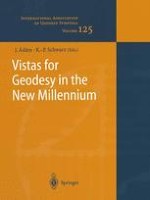
2002 | OriginalPaper | Chapter
Near-Field Deformation of the Imperial Valley, Southern California, from GPS and InSAR Measurements
Authors : S. N. Lyons, Y. Bock, D. T. Sandwell
Published in: Vistas for Geodesy in the New Millennium
Publisher: Springer Berlin Heidelberg
Included in: Professional Book Archive
Activate our intelligent search to find suitable subject content or patents.
Select sections of text to find matching patents with Artificial Intelligence. powered by
Select sections of text to find additional relevant content using AI-assisted search. powered by
Geodetic measurements in the Imperial Valley, southern California, show high strain rates and evidence of fault creep. In May of 1999 and 2000, we surveyed 46 GPS stations in a dense grid (half-mile spacing) along the Imperial Fault using rapid-static mode (15–20 minute occupations). Results indicate the Iimperial Fault is creeping at a rate of 9 mm/yr. The velocity field is asymmetrical across the fault and indicates a dipping fault plane to the northeast. Combining our results with far-field velocities from the Southern California Earthquake Center, we fit the data to a simple elastic dislocation model with 45 mm/yr of rightlateral slip below 10 km and creep from 200–800 m on a dipping plane (85°) to the northeast.North of the Salton Sea, where there is sparse GPS coverage, we used interferometric Synthetic Aperture Radar (InSAR) to determine the interseismic creep signature. Since the landscape over the cropland changes over short time intervals, forming useful interferograms can be challenging. We used permanent scatterers to improve coherence. These permanent scatterers are stable locations that provide estimates of phase, modulo 2πt, and serve to mask poorly correlated areas. Correlation estimates improved for shortbaseline (<100 m), long-timespan (3–8 years) interferograms in this region when using the Permanent Scatterers weighting technique.Results from 69 interferograms revealed a diffuse secular strain buildup, punctuated by two episodes of localized creep. These episodes coincide with the 1992 Landers and 1999 Hector Mine earthquakes and imply triggered slip from these two events. Profiles across this section of the fault show peak-to-trough amplitude ranging from 20 to 50 mm and the deformation pattern is consistent with a model where free slip occurs to a depth of 2 km.